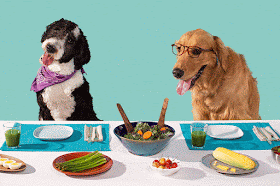And while keeping your dog or cat on a consistent diet isn’t unhealthy, some veterinary nutritionists are raving about an alternative called rotation feeding.
Human nutritionists tell us that food variety is an important part of maintaining a healthy diet, and yet, we don’t think twice about feeding our pets the same food, day after day. I can’t imagine that they enjoy this lack of variety any more than we would.
But in addition to the boredom factor, there are other important reasons for feeding a variety of foods, also known as the rotation diet, or rotation feeding. You can rotate different proteins, brands and flavors on a daily, weekly or monthly basis.
Recommend Reading:
What is Rotation Feeding?
Rotation feeding is really all about variety. It’s a holistic and nutritional philosophy that offers your pet a dietary alternative — varying both food proteins (chicken, beef, lamb, etc.) and food forms (raw, frozen, wet, dry, etc.). This way your dog or cat is able to enjoy and experience different flavors and textures.
When Should I Start My Pet on Rotation Feeding?
It’s much easier to start rotation feeding while he or she is still a puppy or kitten (assuming they are already eating solid food), but that’s not to say an older dog or cat can’t benefit from rotation feeding too.
It just may take a little bit more patience. Often, it’s recommended that small amounts of the new food be blended into the regular diet, so that your pet may become accustomed to the taste and texture of the food slowly, especially if you are switching between brands with different formulations.This may be an issue for some pets.
Benefits Of A Rotation Diet
Proponents of rotation feeding boast about the many health and behavioral benefits, but here are four particular benefits that may interest you:
1. Optimum and complete nutrition. I don’t believe that any one food can be complete and balanced for the life of a pet, no matter what the label says. By combining specific complete diets, rotation feeding allows your pet to experience the benefits of two or more foods.
2. Decrease the risk of developing food allergies. Food allergies can develop when a pet is fed the same protein over a long period of time. If consistently fed the same food, some dogs and cats may develop an allergy or intolerance to common ingredients such as chicken, beef, wheat, corn, or soy. Rotation feeding reduces the risk because the ingredients and formulations are not in your pet’s diet long enough for him or her to develop an adverse reaction, such as vomiting, hives and diarrhea.
3. Creates excitement during mealtime. This prevents your pet from becoming finicky. When your pet eats food with different proteins, textures and flavors, she is less likely to become finicky and stop eating. If your brand changes its formula, or is recalled, you’ll find yourself without a ready alternative you know your pet will eat. With rotation feedings, it’s like a new tasty adventure is waiting for your pet every time they go to their food bowl.
4. Increases water consumption. Water is critical to all life. However, not all pets drink sufficient water. One way to remedy this is to add high moisture foods to your pet’s diet, such as raw frozen foods. This will often prevent health problems such as urinary issues, liver disease and constipation.
How To Feed a Rotation Diet
There is no right or wrong way to feed a rotation diet. You can feed one food in the morning, and a different one at night, or you can change foods weekly, or monthly.
Some pets may experience mild GI upset when changing foods – something that typically doesn’t happen when rotating grain-free canned or raw food.
If your cat has a sensitive stomach, you can rotation feed over a period of a week by gradually mixing in some of the new food with the old and gradually reducing the amount of the old until you’re feeding only the new food.
Probiotics can help ward off any potential GI issues. Regardless of whether you rotation feed or not. It's recommended to use a good probiotic on a daily basis. Probiotics have multiple benefits on not just the intestinal tract, but the immune system as a whole. (Same applies for humans).
Also, keep a feeding diary. Nothing fancy, but keeping track of what you are feeding your dog will help immensely should he or she have difficulty processing a new pet food.
Variety is key to any healthy diet. More commercial diets available today advocate feeding a single food, and this may be needed for a diet trial or for a very sensitive animal who cannot tolerate a variety of foods, but I don’t see this as the norm.
Probiotics can help ward off any potential GI issues. Regardless of whether you rotation feed or not. It's recommended to use a good probiotic on a daily basis. Probiotics have multiple benefits on not just the intestinal tract, but the immune system as a whole. (Same applies for humans).
Also, keep a feeding diary. Nothing fancy, but keeping track of what you are feeding your dog will help immensely should he or she have difficulty processing a new pet food.
If you're making something your pet loves, cook a little piece for her and give a little less kibble in her dish. Sharing your dog/cat safe leftovers is a great way to provide variety for your furbaby.




